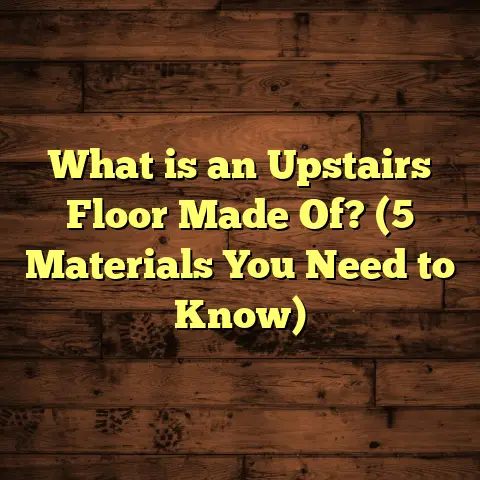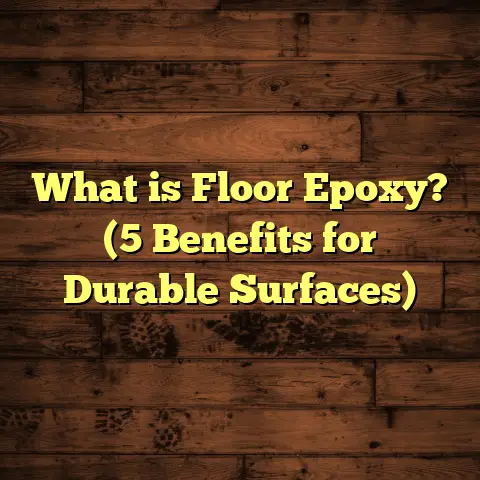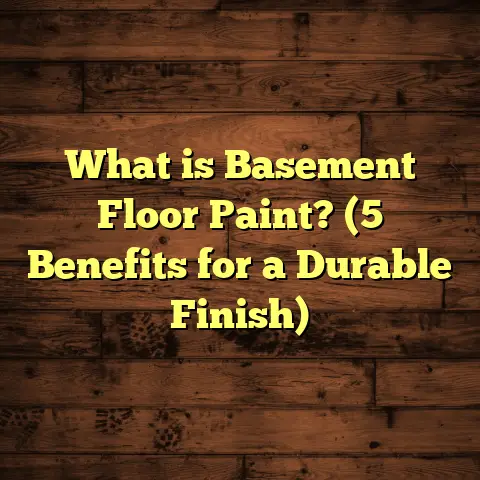What is Floor Made Of? (5 Materials That Define Flooring)
What is Floor Made Of?
Have you ever noticed how floors often play a silent role in our favorite movies or TV shows? Like in Friends, the iconic apartment’s hardwood floors seem to hold all those laughs and heartfelt moments. Or in Game of Thrones, the stone floors of Winterfell give off that raw, ancient vibe that makes the story feel real. Floors are more than just surfaces; they set the tone and mood without us realizing it. When I started working in flooring, I was fascinated by how the choice of material beneath our feet can shape the entire feel of a room.
So, what exactly is a floor made of? What materials are used that make floors strong, durable, beautiful, and sometimes even a bit magical? Over the years, I’ve worked on countless flooring projects—from small apartments to sprawling homes—and I’ve come to appreciate five materials that most often define flooring: hardwood, laminate, vinyl, tile, and carpet. Each has its own story, strengths, and quirks.
Let me take you through these materials, sharing what I’ve learned, some interesting data, and stories from my experience so you get a clear picture of what your floor might be made of or what it could be made of if you’re planning a project.
What Is Flooring?
Before we jump into the materials, let’s clarify what flooring really means. Flooring refers to the permanent covering material applied to the floor surface of a room or building. It’s the layer you walk on every day. But it’s not just about function—flooring also impacts comfort, aesthetics, acoustics, safety, and even energy efficiency.
When I first started installing floors, I thought it was just about putting planks or tiles down. But soon, I realized there’s a lot more to it. Floors have to handle wear and tear from foot traffic, resist moisture in kitchens or bathrooms, provide insulation in cold climates, and sometimes even reduce noise in busy homes or offices.
The right floor can make your home feel inviting and warm or crisp and modern. It can add resale value or be a budget-friendly fix. So, when someone asks me “what is floor made of?”, I think about both the physical materials and what those materials bring to the table.
Hardwood Flooring: The Timeless Classic
What Is Hardwood Flooring Made Of?
Hardwood flooring is made from solid wood planks cut directly from hardwood trees. Common species include oak, maple, cherry, walnut, and hickory. These woods are dense and durable because they grow slowly and develop tight grain patterns.
Each plank is usually 3/4 inch thick and comes in lengths from 12 inches to over 84 inches. Hardwood floors are often finished with polyurethane coatings for protection and shine.
Why Hardwood Stands Out
Hardwood floors have a reputation for beauty and longevity that few other materials match. I remember one client who had an original oak floor in their 1920s home. When we refinished it, it literally looked brand new—like stepping back in time but with modern durability.
According to the National Wood Flooring Association (NWFA), hardwood floors can last over 100 years if maintained well. That longevity makes hardwood a great investment.
Hardwood by the Numbers
- Cost: Hardwood floors typically cost between $8 to $15 per square foot installed.
- Durability: Janka hardness scale rates wood species; for example:
- Red Oak: 1290
- Hard Maple: 1450
- Hickory: 1820
- Environmental Impact: Hardwood is renewable if sourced responsibly; look for FSC (Forest Stewardship Council) certification.
Installation Insights
Installing hardwood requires a stable subfloor. It can be nailed or glued down depending on the type (solid or engineered). Because of its thickness, hardwood can be sanded and refinished multiple times over decades—a big plus for longevity.
One tricky part I’ve encountered is acclimating hardwood before installation. Wood expands or contracts based on humidity levels. If you don’t allow it to adjust to your home environment before installation, you might end up with gaps or buckling later.
Maintenance Tips
- Sweep or vacuum regularly to avoid scratches.
- Use furniture pads under heavy items.
- Avoid water spills—if any occur, wipe quickly.
- Refinish every 7-10 years depending on wear.
Laminate Flooring: Affordable Style with Practical Benefits
What Is Laminate Flooring Made Of?
Laminate flooring consists of multiple layers fused together:
- Wear Layer: A tough transparent coating protects against scratches.
- Design Layer: A high-resolution image layer that mimics wood, stone, or tile.
- Core Layer: Usually made of high-density fiberboard (HDF) providing structural support.
- Backing Layer: Balances moisture and adds stability.
Because it’s mostly fiberboard with a printed design on top, laminate offers a great look for less money compared to real wood or stone.
Why Laminate Got Popular Fast
I remember early in my career when laminate exploded in popularity—it was affordable, easy to install with click-lock systems, and looked quite convincing from afar.
Laminate is great for homeowners wanting the look of hardwood without the maintenance headaches or upfront cost.
Cost and Durability Stats
- Cost: $2 to $5 per square foot installed.
- Durability: Scratch-resistant top layer; good for pets and kids.
- Lifespan: Typically 10-25 years depending on quality.
In my projects, laminate performs well in living rooms and bedrooms but rarely do I recommend it for bathrooms or basements due to moisture vulnerability.
Installation Experience
Laminate installs fast with floating floor systems—no nails or glue required. I’ve helped many DIY clients use laminate successfully thanks to this ease of installation.
One story sticks out: A client tried laminate in their bathroom despite my advice against it. After a year of water exposure near the tub, the floor swelled badly and needed full replacement. That taught both of us a valuable lesson about material choice for moisture-prone areas.
Care Advice
- Clean with a damp mop—not soaking wet.
- Avoid abrasive cleaners.
- Don’t wax laminate floors.
Vinyl Flooring: The Waterproof Chameleon
What Is Vinyl Flooring Made Of?
Vinyl flooring is made primarily from polyvinyl chloride (PVC), plasticizers for flexibility, and pigments for color. It can come as sheet vinyl, vinyl tiles (VCT), or luxury vinyl planks (LVP).
Luxury vinyl planks have surged in popularity because they combine waterproof durability with realistic wood grain textures.
Benefits That Make Vinyl Shine
I’ve installed vinyl floors in everything from hospitals to trendy cafes because they’re:
- Waterproof
- Durable
- Easy to clean
- Versatile in style
In one commercial project, vinyl planks saved the day when moisture from frequent cleaning would have ruined hardwood.
Vinyl Cost and Longevity
- Cost: $2 to $7 per square foot installed.
- Durability: Can last 10-20 years depending on wear layer thickness.
Vinyl flooring wear layers vary from 6 mils (light residential use) up to 40 mils for heavy commercial applications.
Installation Know-How
Vinyl can be glued down or installed as loose lay planks with adhesive strips. It’s less labor-intensive than tile or hardwood but requires a smooth subfloor.
One challenge I faced was getting vinyl sheets perfectly flat without bubbles; that took patience and skill.
Care Tips
- Regular sweeping and mopping with mild detergents.
- Avoid abrasive scrubbers.
- Use floor protectors under furniture.
Tile Flooring: Durable Beauty From Nature and Craft
What Are Tiles Made Of?
Tiles come in several types:
- Ceramic Tiles: Made from clay mixed with natural minerals fired at lower temperatures.
- Porcelain Tiles: A denser type of ceramic fired at higher temperatures for added strength.
- Natural Stone Tiles: Marble, granite, slate — quarried stone cut into tile shapes.
Each type has unique looks and properties.
Why Choose Tile?
I’ve worked on many kitchen remodels where clients want tile for its durability, water resistance, and design options—from rustic terracotta to sleek porcelain.
Tiles can last decades if properly installed and maintained—some ancient buildings still have original stone tiles intact after centuries!
Cost and Durability Data
- Cost: $5 to $15 per square foot installed depending on type and complexity.
- Hardness: Porcelain has hardness ratings around 7 on Mohs scale (good scratch resistance).
Tile is great for wet areas but grout lines need upkeep to prevent stains or mold growth.
Installation Tips From My Experience
Tile installation requires skill: surface prep is key, tiles must be level with tight grout joints, and cuts around corners demand precision.
One memorable project involved restoring old subway tiles in a historic home, which demanded matching vintage patterns—a true puzzle but rewarding when finished.
Maintenance Musts
- Clean grout regularly with mild cleaners.
- Seal natural stone tiles yearly.
- Replace cracked tiles promptly.
Carpet: Softness That Brings Warmth and Comfort
What Is Carpet Made Of?
Carpet fibers come from:
- Nylon: Durable and stain-resistant.
- Polyester: Soft but less durable.
- Olefin (Polypropylene): Water-resistant but prone to matting.
- Wool: Natural fiber that’s luxurious but expensive.
These fibers are twisted into yarns then tufted or woven into backing materials that hold everything together.
Why People Still Love Carpet
I often recommend carpet for bedrooms and family rooms where comfort matters most. It feels cozy underfoot and absorbs sound better than hard surfaces—ideal for busy households.
Carpet Cost & Lifespan
- Cost: $3 to $7 per square foot installed.
- Lifespan: 5 to 15 years depending on quality and traffic level.
Carpet tends to show wear faster than hard surfaces but replacing it can refresh a room affordably.
My Carpet Stories
One client with two energetic toddlers chose nylon carpet for its stain resistance. Over several years, it held up surprisingly well despite spills and rough play—a testament to fiber quality.
On the flip side, I’ve seen polyester carpets fade quickly under strong sunlight, so placement matters too.
Care Guide
- Vacuum frequently to remove dirt and allergens.
- Spot clean spills immediately.
- Deep clean professionally every one to two years.
The Role of Subflooring & Underlayment
Now that we’ve covered surface materials, it’s worth mentioning what lies beneath—the subflooring and underlayment.
Good subfloors provide stability, prevent squeaks, and help absorb sound or moisture depending on material used.
Common subfloor materials include:
- Plywood
- OSB (Oriented Strand Board)
- Concrete slabs
Underlayment adds cushioning under laminate, vinyl, or hardwood floors, and can serve as moisture barriers or soundproofing layers.
In my experience, neglecting subfloor prep results in uneven floors, premature wear, and unhappy homeowners!
How I Estimate Costs: Using FloorTally for Smarter Budgets
Estimating costs was one of my biggest headaches early on. Material prices vary by region; labor costs depend on complexity; and you always want to factor in waste—extra material needed due to cuts or errors.
I started using FloorTally—a tool that pulls local data automatically—to help me create accurate budgets quickly. It lets me:
- Choose material types & qualities
- Input room dimensions
- See labor & material costs broken down
- Account for waste percentages
This tool saves me hours chasing quotes or guessing numbers. Plus, it helps clients visualize where their money goes, so they can make better decisions about upgrades or compromises.
If you’re planning your own project, try inputting your details into something like FloorTally before buying anything—that little effort upfront pays off big later!
Flooring Trends & Design Considerations I’ve Seen Evolve
Over the years, flooring styles have shifted quite a bit. Some trends stuck around; others faded fast.
Here are some observations:
- Wide Plank Hardwood: Larger boards became popular for a modern yet rustic look.
- Luxury Vinyl Planks (LVP): Gained ground as affordable waterproof hardwood alternatives.
- Mixed Materials: Combining tile and wood within open floor plans adds interest.
- Eco-Friendly Choices: Bamboo flooring and recycled-content carpets appeal more now.
Personally, I enjoy helping clients blend function with style— like choosing textured ceramic tile that hides dirt better for busy kitchens or warm wool rugs over hardwood in living rooms for comfort zones.
Final Thoughts on Flooring Choices
Floors are foundational—not just structurally but emotionally too. They carry memories of bare feet running across rooms, quiet evenings reading by the fire, family gatherings full of laughter.
When someone asks me “what is floor made of?” I like to think about all these layers: material science, installation technique, and personal lifestyle needs rolled into one choice beneath your feet.
Whether you go classic hardwood, budget-friendly laminate, waterproof vinyl, durable tile, or cozy carpet, each tells its own story about how you live in your space.
If you want advice on which material fits your home best, or need help estimating costs realistically using tools like FloorTally, just ask—I’m happy to share what I’ve learned from thousands of square feet laid down over the years!
And hey—what’s your floor story? Maybe it’s old pineboards creaking underfoot, or shiny ceramic tiles catching sunlight just right. Whatever it is, that’s what makes your house a home.
If you want me to add more details on specific parts like installation techniques, maintenance routines, or environmental impact stats with references, just say so!





